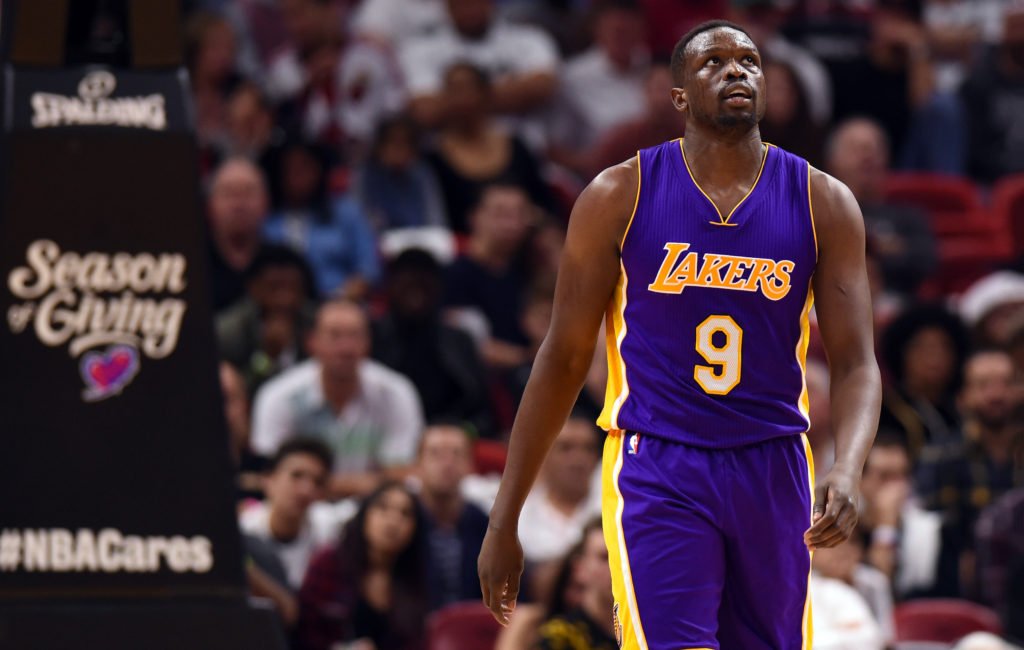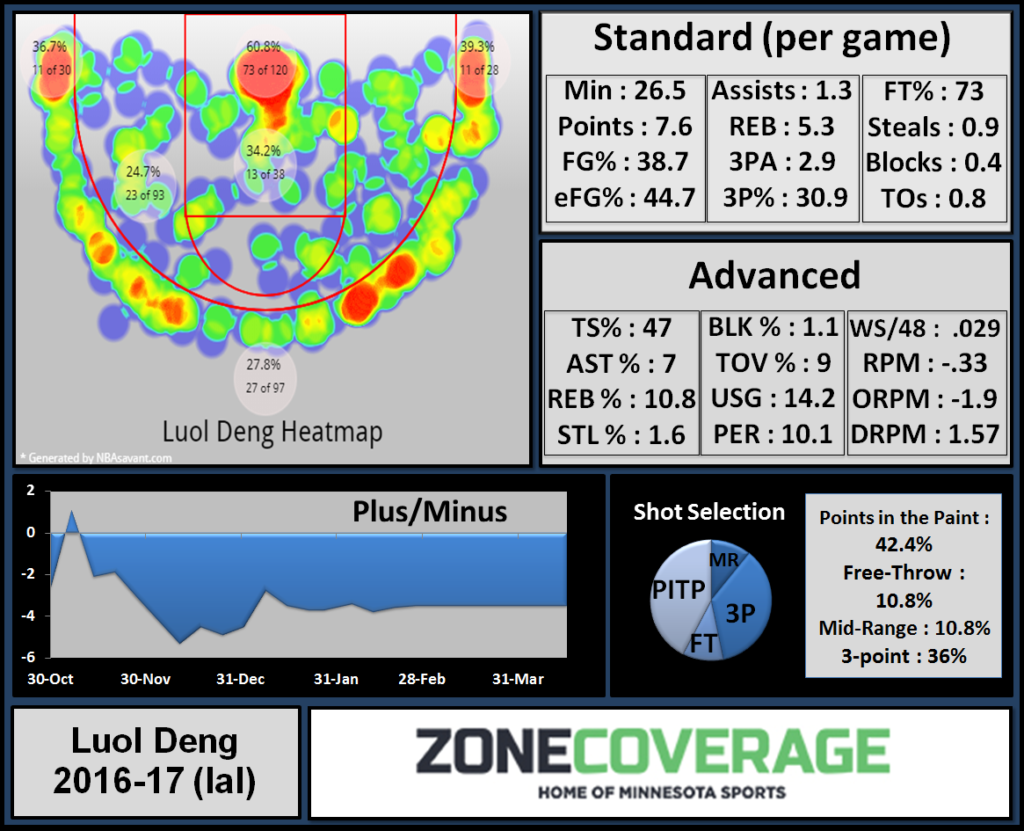Charlie Johnson (@CjohnsNBA) contributed to this story.
The Minnesota Timberwolves preseason is here. Additional player profiles below.
- Jeff Teague
- Derrick Rose
- Tyus Jones
- Andrew Wiggins
- James Nunnally
- Josh Okogie
- Jimmy Butler
- Keita Bates-Diop
- C.J. Williams
- Anthony Tolliver
- Taj Gibson
Since being drafted in 2004, Luol Deng has played 30,549 minutes in 880 regular season NBA games. He’s a physical forward that has consistently made an impact in a myriad of ways. Deng’s impressive basketball IQ can be seen in the way that he cuts, moves in space and defends his position; his playstyle is well summed up by the fact that he earned two all-star bids — 2011-12 and 2013-14 — while averaging less than 17 points per game.
After 10 seasons with the Chicago Bulls – three of which were played under head coach Tom Thibodeau – Deng was traded to the Cavaliers in January of 2014 to finish out the season. Following 40 games in Cleveland, he played two effective seasons with the Miami Heat.
Then, in the wake of 2016’s unprecedented salary-cap spike, Deng (31 at the time) signed a four-year, $72 million deal with the Los Angeles Lakers. He wore purple and gold in 56 contests through the 2016-17 campaign but appeared in just one game the following season as a casualty of the Lakers’ movement toward youth.
On the first day of September, Deng agreed to a contract buyout with Lakers brass – through the deal, he relinquished $7.5 million of guaranteed money in order to purchase his free agency.
Not long after, Deng signed a one-year, veteran minimum contract to join Thibodeau and the Minnesota Timberwolves. Let’s dig into his player profile.
Statistical Profile
- Luol Deng’s 2016-17 heat map demonstrates a willingness to shoot from anywhere on the floor.
• He compiled career-lows in minutes per game, and subsequently, most counting statistics.
• It was Deng’s first season shooting below 40-percent from the field
• He attempted more 3-point shots per 36 minutes (4.0) than he has during any other season
• Despite his struggles, Deng ranked 28th of 72 qualified small forwards by ESPN’s Real Plus/Minus
Role On Wolves
Outside of any playing time he’s destined to receive, Deng figures to inject another dose of veteran savvy into the pack he’s chosen to join. Playing under Thibodeau for three seasons in Chicago – three of Deng’s best – he acquired a thorough understanding of the coach’s intricate defensive scheme.
Whether he utilizes this fact to add value through mentorship or on-court production, such expertise could be invaluable to a team that has struggled to improve on that end of the floor. In theory, impressing systematic knowledge onto Andrew Wiggins could pay dividends for this franchise that far exceed Deng’s minimum salary.
Still, a number of signs point toward him filling an on-court role this coming season.
Before competing in the 2018 NBA Africa Game, Deng spoke to Stuart Hess of Independent Online about his state of mind: “I want to play, I want to be a part of something,” he said adamantly.
If we are to take Deng at his word – that playing time is a priority of his moving forward – we can also assume that this was discussed when he and Thibodeau came to terms on a contract. And though a coach is not beholden to assurances they make a player, as we found out with Jamal Crawford last year, there’s a very high degree of respect and trust between these two professionals.

Before struggling through his time in Los Angeles, Deng played valiantly as a member of the post-LeBron Heat. In 2015-16, he started in 73 or his 74 appearances, averaging just over 32 minutes per game. In all, he put up 12.3 points, six rebounds and 1.9 assists per night to help the Heat claim the Eastern Conference’s third seed. And through 14 postseason contests, he compiled 13.3 points, 5.9 rebounds and 1.6 assists on impressive shooting clips (.471/.421/.842).
Though it’s a valid – albeit almost unanswerable – concern to wonder what’s left in his tank, Deng contends he has more to offer.
Within the Wolves’ revamped group of reserves, he might not actually need to manifest statistical production in order to warrant a role. Given his schematic intelligence and ceaseless motor, effort and leadership could ultimately be what makes this signing a success.
As we discussed in Anthony Tolliver’s player profile, the Wolves’ bench ranked dead last by defensive rating a season ago. In formulating a strategy to address that downfall, Thibodeau seems to have identified newcomers that can provide a refreshed persona.
As much a power forward as he is a small forward at this point in his career, a healthy Deng’s two-way aptitude could slot in a number of Timberwolves lineups.
“I’m not going to be a part of a place where you don’t believe in me,” Deng told Hess in August. “I’m not trying to knock anybody, but I play for people who believe in me.”
Thibodeau believes.
Film Clipboard
For Deng in Los Angeles, it wasn’t so much that the Lakers asked him to do too much, it was that they rarely helped him do anything. This was a massive departure from the “system-based” teams Deng played for in Chicago and Miami. Though Deng’s usage dropped in Los Angeles, how he was used was comparatively empty in comparison to his previous spots.
While part of this falls on Deng himself, the teammates he played with didn’t help. Brandon Ingram was a rookie, D’Angelo Russel had one year of NBA experience and Julius Randle was functionally a second-year player as well. Simply put: his Lakers teammates had a far lower understanding of the game. These teammates, when they frequently became lost in the offense, looked for Deng as a bailout and this often put him in difficult situations.
Watch Randle’s eyes in the above play during one of the Lakers’ Point Randle experiments. The young Randle only really knows how to do one thing: put his head down and get to the bucket. On this play, he pulls up lame as he hits the wall of the Brooklyn defenders (great cut D’Angelo!) and awkwardly sprays the ball over to Deng for a difficult fading jumper.
To be fair, and to put some blame on Deng, he shoots the shot. There was still plenty of time on the shot clock to keep the ball moving. In Minnesota, he’ll have to be more patient than this:
Optimistically, the outlook in Minnesota is brighter due to the presence of more higher IQ — and more mature — teammates. Deng had a few bouts of success in L.A. when he shared the floor with Jose Calderon, a point guard whose greatest attribute is his vision.
Watch here as Deng is able to read the action of Calderon’s penetration and cut towards the hoop rather than towards the ball in the ways he did with Randle.
Calderon better understood the situations that put Deng in the best place to succeed and did a better job of putting him there. On this play, Calderon not only feeds the ball into the post, but places the ball in a place that only Deng can get to it. This optimizes Deng’s ability to score after the catch.
But Deng’s success or failure is not all dependent on his teammates. In L.A., he showed two key developing weaknesses:
1.) Inconsistent shot mechanics
2.) Devolved athleticism on drives
The shot is probably the most discouraging, as it would be ideal for the Wolves to at least occasionally use Deng in spot-up situations. A journey into the film of his shot is not a pleasant experience.
Watch Deng’s upper-body shots mechanics — particularly his hands — on this open 3-point attempt.
Compare the spraying of his wrists on that shot to the overcorrection in follow through of this shot. His 165 3-point attempts in 2016-17 were an exercise in trying to find something that worked. He never found it — only converting 51 of those attempts (30.9 percent).
Equally discouraging were many of Deng’s drives. Time and again, he lacked the speed and power to overcome even small defenders on switches. His attacks were not direct to the rim; they looped and winded, sometimes even against smaller opponents. Notice how the 220-pound Deng consistently comes up short on these attempts against Tim Frazier (170 pounds) and Rajon Rondo (185 pounds).
And here, Deng does not have faith in his strength to go into the hulking Robin Lopez; instead, pulling up for an awkward floater that also comes up (very) short.
All isn’t lost with Deng. Theoretically, his role is even smaller with the Wolves than it was with the Lakers. Tom Thibodeau seems to believe that through playing with players who better know Deng’s strengths and weaknesses — and a system that asks him to do even less — that he can find a role to be a positive contributor if and when he sees the floor.
To find additional Zone Coverage player profiles follow the below. Links to be updated throughout the preseason.
- Jeff Teague
- Derrick Rose
- Tyus Jones
- James Nunnally
- Andrew Wiggins
- Josh Okogie
- Jimmy Butler
- Keita Bates-Diop
- C.J. Williams
- Anthony Tolliver
- Taj Gibson













